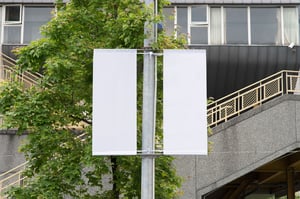what type of ink is used to screenprint road signs
What are the near common types of vinyl signs? Before the widespread use of printers, a lot of signs were manus-painted. Often, vinyl media was called every bit a canvass for its portability — it's lightweight, easy to whorl, and affordable. Getting a sign paw-painted meant hiring a professional person painter to design, lay out, and execute the artwork. [Free Whitepaper: Selecting the correct Inkjet Printer for your Banner Sign] Hand-painted vinyl signs are rare these days. While custom hand lettering is condign popular again for shop windows, vinyl signs are easily made using screens or printers. One reason for their disappearance? Hand-painted vinyl signs aren't particularly rugged and don't stand up up well to the elements. Screen-printed vinyl signs are more common than hand-painted ones. They operate on a similar principle — applying ink manually to the vinyl to create lettering and graphics. Screens produce high-quality images and text with precipitous lines by using stencils to employ layers of color. Screen-printed outdoor banners and signs are normally reserved for instances where a large number of the same imprint is needed, making screen printing a price-effective solution. Large-format printing has made most other forms of vinyl sign production obsolete in all merely a few cases. Today's large-format inkjet printers apply durable pigments that are designed to stand against rain, snow, and sunday. These pigments come in a diverseness of forms, including h2o-based inks, standard solvent-based inks, eco-solvent, or UV-curable inks. Digital inkjet printers tin produce photo-quality prints on vinyl imprint cloth chop-chop and inexpensively. Nearly banners and vinyl signs you lot run across today came from a professional grade digital inkjet printer. While all vinyl banners are fabricated from PVC, non all vinyl sign materials are the aforementioned. Unlike printing processes require specific materials to work, and choosing the incorrect vinyl can lead to low-quality results. Screen-class vinyl is designed for use with screen printing apparatuses. It features loftier dot gain (the size and number of indents on its surface) to ensure that ink fully and evenly covers the material. Screen-form vinyl is usually lighter in manus and flexible — in role considering it's often made inexpensively overseas. Inkjet-grade vinyl is a more than technically sophisticated material with less dot proceeds to arrange precision inkjet heads. Inkjet-form vinyl unremarkably has a stiffer manus, which helps it withstand the rolling and heat that'southward involved in press. High-grade inkjet vinyl media will accept a host of different solvents and inks, making it versatile enough for just about every printer in the store. Printing screen-course vinyl on large-format inkjet printers leads to a host of problems, from poor image quality to wrinkling and jamming. In add-on, nigh screen-grade vinyl isn't curl-free, meaning it'south non designed for rollers and will curl almost immediately out of the printer. The simplest manner to brandish your sign is a hanging banner. Once printed, your banner will be hemmed along the edges for a clean look and affixed with either grommets or pole pockets, depending on your intended use. Hanging banners can be hung on the fronts of buildings, suspended from awnings, or stuck into the ground with poles. Low-cal mail service-manner banners use ii pockets on the tiptop and bottom of the banner to pull information technology taut between metal rods. This multifariousness of imprint is commonly printed double-sided, using two pieces of single-sided cloth or ane loftier-quality double-sided vinyl imprint. A newer way of advertizing on the become, vehicle wraps use static cling or magnetic adhesive vinyl pieces to wrap a car or truck with a graphic. In many cases, these adhesives are removable. Like static cling/magnetic adhesive vinyl signs can exist used for advertizement on shop windows. Printed vinyl banners tin be pulled tight over billboard frames to easily produce large outdoor advertisements. Billboard wrapping requires a high-quality vinyl media in order to prevent the ripping, stretching, and wilting that comes with big-scale mounting. Hardback signs use agglutinative vinyl stickers placed on rigid substrates to create free-standing signage. This method is pop for political campaigns, lawn advertising, and more than. Hardback signs are popular because they require piddling more than a wire clip or unmarried pole to stand upright. Look around and you'll discover how many unlike forms vinyl signs can take in today's world. A lot of companies gravitate toward vinyl signs every bit a cost-effective solution for their advertising needs. Knowing what kind of signs are bachelor helps marketers and print shop owners come upwardly with more creative, eye-catching signage. Larn more than almost digital printing techniques and commonly used ink types by downloading our free whitepaper today!  Few forms of advertising are as versatile, affordable, and effective as a well-placed vinyl sign. Nowadays, outdoor vinyl signs come in a variety of shapes and sizes. Whether you're a print shop possessor looking to expand your offerings or a modest business organization owner looking to gain a leg up on the competition, vinyl signs may be the solution for you.
Few forms of advertising are as versatile, affordable, and effective as a well-placed vinyl sign. Nowadays, outdoor vinyl signs come in a variety of shapes and sizes. Whether you're a print shop possessor looking to expand your offerings or a modest business organization owner looking to gain a leg up on the competition, vinyl signs may be the solution for you.PRINT Style
Hand-PaintedScreen-Printed
Digital Inkjet Printing
MATERIALS
Screen-Grade VinylInkjet-Grade Vinyl
SUSPENSION METHODS
Hanging BannerCalorie-free Post Banner
Vehicle Wraps
Billboard Wrap
Hardback

pictonfrinslazince.blogspot.com
Source: https://www.bantexdigital.com/blog/most-common-types-outdoor-vinyl-signs